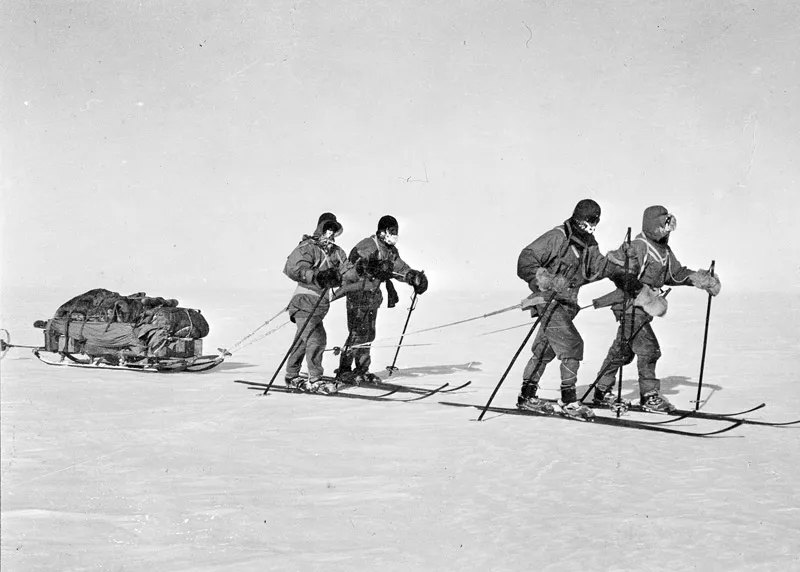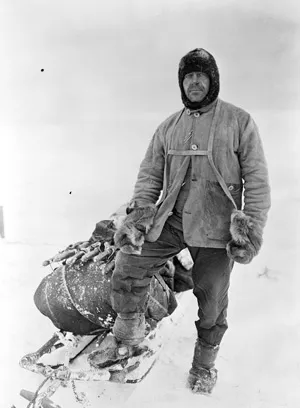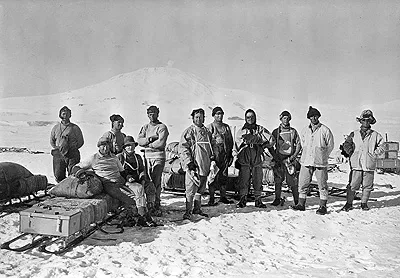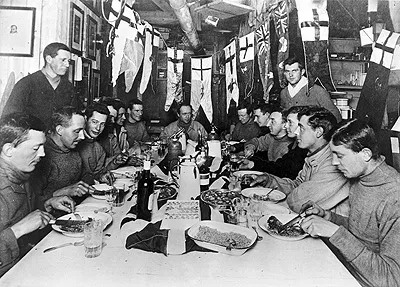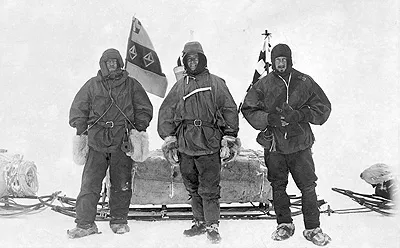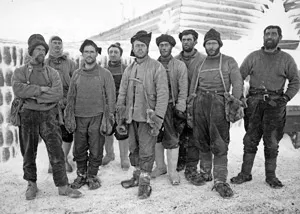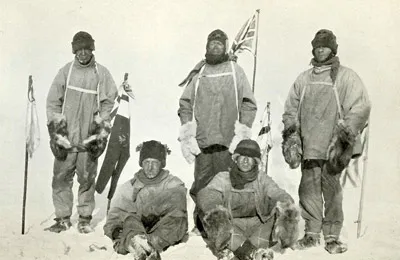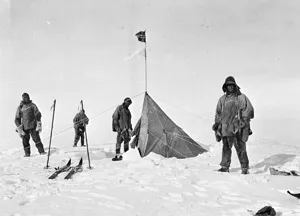Robert Falcon Scott - Commander R.N.
1868-1912 - Biographical
notes
Scott's Journey: page 1 - preparations | page 2 - the polar journey | time-line and info graphic | crew of the Terra Nova | what did Scott's team die of? | why didn't Scott return successfully from the pole?
Expedition leader -
Discovery
1901-04
Expedition leader
Terra Nova
1910-13
.webp)
Robert Scott
6th June 1868 - 29th
March 1912
Born into a fairly well to do family in Devon, England, Scott began his naval career in 1881 at the age of 13. His father later sold the brewery he owned, the source of the family income, lost the capital in unwise investments and subsequently died in 1897. Scott's brother died in 1898, at which point his mother and two unmarried sisters became dependent on his naval pay alone, promotion and extra income became a priority.
A chance encounter with Sir Clements Markham in 1899 led to Scott being offered the command of the Discovery Expedition to Antarctica. He had no polar experience and no real interest beyond the promotion it represented, though the expedition was deemed a great success in both exploration and scientific research, he became a popular hero on his return in 1904.
The Terra Nova Expedition was again planned to be a far-ranging scientific and exploratory enterprise with one of the stated aims being to reach the South Pole. What became the "Race to the Pole" with Amundsen was not of Scott's making or planning, his party became the second expedition to reach the South Pole in 1912, all five members perished on the return journey.
When the news of the South Polar Party reached the UK they were feted as national heroes of the most noble kind, a memorial service led by the King was held in St. Paul's Cathedral within days. Public subscriptions raised £75,509 (the equivalent of over £6 million today) which paid off the expedition debts, and provided money for the families of the dead men, the remaining sum of £12,000 was given to Cambridge University to found the Scott Polar Research Institute, still a world renowned research facility, polar library and museum.
In more recent years controversies over Scott's planning, leadership and personality somewhat overshadowed the extensive wider exploratory and scientific achievements of his two expeditions and of his significant legacy. In the way of such things, the pendulum has once again swung in Scott's favour and some of what were seen as failings are seen more as him being a product of his time and of better understandings of what was known then.
References to Robert Scott by Cherry-Garrard in "The Worst Journey in the World"
-
The trouble is that they are inclined to lose their ideals in this complicated atmosphere of civilization. They run one another down like the deuce, and it is quite time that stopped. What is the use of A running down Scott because he served with Shackleton, or B going for Amundsen because he served with Scott? They have all done good work; within their limits, the best work to date. There are jobs for which, if I had to do them, I would like to serve under Scott, Amundsen, Shackleton and Wilson - each to his part. For a joint scientific and geographical piece of organization, give me Scott; for a Winter Journey, Wilson; for a dash to the Pole and nothing else, Amundsen: and if I am in the devil of a hole and want to get out of it, give me Shackleton every time. They will all go down in polar history as leaders, these men. I believe Bowers would also have made a great name for himself if he had lived, and few polar ships have been commanded as capably as was the Terra Nova, by Pennell.
-
Cook, Ross and Scott: these are the aristocrats of the South.
-
The ration of food was inadequate and they became very hungry as time went on; but it was not until December 21 that Wilson disclosed to Scott that Shackleton had signs of scurvy which had been present for some time. On December 30, in latitude 82° 16' S., they decided to return. By the middle of January the scurvy signs were largely increased and Shackleton was seriously ill and spitting blood. His condition became more and more alarming, and he collapsed on January 18, but revived afterwards. Sometimes walking by the sledge, sometimes being carried upon it, Shackleton survived: Scott and Wilson saved his life. The three men reached the ship on February 3, after covering 960 statute miles in 93 days. Scott and Wilson were both extremely exhausted and seriously affected by scurvy. It was a fine journey, the geographical results of which comprised the survey of some three hundred miles of new coast-line, and a further knowledge of the Barrier upon which they travelled.
-
Nothing was left undone for them which we could manage, but necessarily the Antarctic is a grim place for ponies. I think Scott felt the sufferings of the ponies more than the animals themselves.
-
Scott, who always amazed me by the amount of work he got through without any apparent effort, was essentially the driving force of the expedition: in the hut quietly organizing, working out masses of figures, taking the greatest interest in the scientific work of the station, and perhaps turning out, quite by the way, an elaborate paper on an abstruse problem in the neighbourhood; fond of his pipe and a good book, Browning, Hardy (Tess was one of his favourites), Galsworthy. Barrie was one of his greatest friends.
-
Sledging he went harder than any man of whom I have ever heard. Men never realized Scott until they had gone sledging with him.
-
England knows Scott as a hero; she has little idea of him as a man. He was certainly the most dominating character in our not uninteresting community: indeed, there is no doubt that he would carry weight in any gathering of human beings. But few who knew him realized how shy and reserved the man was, and it was partly for this reason that he so often laid himself open to misunderstanding.
Add to this that he was sensitive, femininely sensitive, to a degree which might be considered a fault, and it will be clear that leadership to such a man may be almost a martyrdom, and that the confidence so necessary between leader and followers, which must of necessity be based upon mutual knowledge and trust, becomes in itself more difficult. It wanted an understanding man to appreciate Scott quickly; to others knowledge came with experience.
He was not a very strong man physically, and was in his youth a weakly child, at one time not expected to live. But he was well proportioned, with broad shoulders and a good chest, a stronger man than Wilson, weaker than Bowers or Seaman Evans. He suffered from indigestion, and told me at the top of the Beardmore that he never expected to go on during the first stage of the ascent.
Temperamentally he was a weak man, and might very easily have been an irritable autocrat. As it was he had moods and depressions which might last for weeks, and of these there is ample evidence in his diary. The man with the nerves gets things done, but sometimes he has a terrible time in doing them. He cried more easily than any man I have ever known.
What pulled Scott through was character, sheer good grain, which ran over and under and through his weaker self and clamped it together. It would be stupid to say he had all the virtues: he had, for instance, little sense of humour, and he was a bad judge of men. But you have only to read one page of what he wrote towards the end to see something of his sense of justice. For him justice was God. Indeed I think you must read all those pages; and if you have read them once, you will probably read them again. You will not need much imagination to see what manner of man he was.
And notwithstanding the immense fits of depression which attacked him, Scott was the strongest combination of a strong mind in a strong body that I have ever known. And this because he was so weak! Naturally so peevish, highly strung, irritable, depressed and moody. Practically such a conquest of himself, such vitality, such push and determination, and withal in himself such personal and magnetic charm. He was naturally an idle man, he has told us so; he had been a poor man, and he had a horror of leaving those dependent upon him in difficulties. You may read it over and over again in his last letters and messages.
He will go down to history as the Englishman who conquered the South Pole and who died as fine a death as any man has had the honour to die. His triumphs are many - but the Pole was not by any means the greatest of them. Surely the greatest was that by which he conquered his weaker self, and became the strong leader whom we went to follow and came to love.
Landmarks named after Robert Falcon Scott
Feature Name:
Scott Coast
Type: beach
Latitude:
76°30'S
Longitude: 162°30'E
Description: That portion of the coast
of Victoria Land between Cape Washington and Minna Bluff. Named
by NZ-APC in 1961. Much of the early exploration of this coastline
was accomplished by Scott and his colleagues, and many of the
names in the region were bestowed by him.
Feature Name:
Scott Glacier
Type: glacier
Latitude:
66°30'S
Longitude: 100°20'E
Description: Glacier, 7 mi wide and over
20 mi long, flowing NNW to the coast between Cape Hoadley and
Grace Rocks. Discovered by the Western Base Party of the AAE
(1911-l4) under Mawson.
Feature Name:
Scott Glacier
Type: glacier
Latitude:
85°45'S
Longitude: 153°00'W
Description: A major glacier, 120 mi long,
originating on the polar plateau in the vicinity of D'Angelo
Bluff and Mount Howe, and descending between Nilsen Plateau
and the mountains of the Watson Escarpment to enter Ross Ice
Shelf just W of Tapley Mountains. Discovered in December 1929
by the ByrdAE geological party under Laurence Gould. Named by
US-ACAN.
Feature Name:
Scott Icefalls
Type: glacier
Latitude:
85°32'S
Longitude: 170°15'E
Description: Extensive icefalls near the
head of Mill Glacier, between Otway Massif and the S part of
Dominion Range. Named by the NZGSAE (1961-62).
Feature Name:
Scott Island
Type: island
Latitude:
67°24'S
Longitude: 179°55'W
Description: An island, 0.25 mi long and
half as wide, lying 315 mi northeastward of Cape Adare, the
northeastern extremity of Victoria Land. Discovered in December
1902 by Lt. William Colbeck, RNR, commander of the Morning,
relief ship for Capt. Robert F. Scott's expedition. Named
by Colbeck.
Feature Name:
Scott Seamounts
Type: summit
Latitude:
68°00'S
Longitude: 179°50'W
Description: Seamounts named in association
with Scott Island. Name approved 6/88 (ACUF 228).
Feature Name:
Scott Mountains
Type: summit
Latitude:
67°30'S
Longitude: 050°30'E
Description: A large number of isolated
peaks lying S of Amundsen Bay in Enderby Land. Discovered on
Jan. 13, 1930 by BANZARE under Sir Douglas Mawson. He named
the feature Scott Range after Capt. Robert F. Scott, RN. The
term mountains is considered more appropriate because of the
isolation of its individual features.
Feature Name:
Scott Nunataks
Type: summit
Latitude:
77°14'S
Longitude: 154°12'W
Description: Conspicuous twin elevations
which form the N end of the Alexandra Mountains on Edward VII
Peninsula. Discovered in 1902 by the BrNAE under Capt. Robert
F. Scott, RN. Named after Scott by Lt. K. Prestrud, leader of
the Eastern Sledge Party of Amundsen's Norwegian expedition
who ascended the features while exploring Edward VII Peninsula
in 1911.
Feature Name:
Mount Scott
Type: summit
Elevation:
880
Latitude: 65°09'S
Longitude: 064°03'W
Description:
Horseshoe-shaped massif, 880 m, open to the SW with
its convex side fronting on Girard Bay and its NW side on Lemaire
Channel, on the W coast of Graham Land. Discovered by the BelgAE,
1897-99. Mapped by Dr. Jean B. Charcot, leader of the FrAE,
1908-10.
Variant Name(s) - Massif Scott
Other Crew of the Terra Nova Expedition
Abbot,
George Percy - Petty Officer, R.N. - 1, 2, N
Atkinson, Edward
L. - R.N. - surgeon, parasitologist - 1, 2, D, P, S
Balson,
Albert - Leading seaman, R.N.- 1, 2
Bowers,
Henry Robertson - Lieutenant - 1, 2, D, C,
Po
Browning,
Frank Vernon - Petty Officer - 1, 2, N
Campbell,
Victor - Lieutenant, R.N. - 1, 2, N
Cheetham,
Alfred B. - Boatswain (Bosun), R.N.R.
Cherry-Garrard,
Apsley - Assistant zoologist - 1, 2, D, C, S
Crean,
Tom - petty officer, R.N. - 1, 2, D, P, S
Debenham, Frank
- Geologist - 1, 2, iW, iiW
Dickason,
Harry - Able Seaman - 1, 2, N
Evans, Edgar - petty
officer, R.N. - 1, iW, Po
Evans, Edward R.G.R. - Lieutenant, R.N. "Teddy Evans" -
second in command, and Captain of the Terra Nova - 1, D, P
Girev
(Geroff), Dmitriy - Dog driver - 1, 2, D, P, S
Gran,
Tryggve - ski expert - 1, 2, D, iiW, S
Lashly, William
- chief stoker, R.N. - 1, 2, P, S
Levick,
G. Murray - Surgeon, R.N. - 1, 2, N
Lillie, Dennis Gascoigne - Biologist
on the ship
McLeod, Thomas
F. - Able seaman - 1, 2
Meares, Cecil
H. - in charge of dogs - 1, D, P
Oates, Lawrence
- Capt. 6th Iniskilling Dragoons - 1, D,
Po
Ponting,
Herbert G. - Camera artist - 1
Priestley,
Raymond E. - Geologist - 1, 2, N
Omelchenko,
Anton - Groom - 1
Scott, Robert
Falcon - Commander, R.N. -
Expedition leader - 1, D, Po
Simpson,
George - Meteorologist - 1
Taylor,
T. Griffith - Geologist - 1, iW, iiW
Wilson,
Edward Adrian - chief of scientific staff and biologist - 1, D, C,
Po
Wright,
Charles Seymour - Physicist - 1, 2, iW, P, S
Key:
1 - first winter
2 - second winter
iW - first western party
iiW - second western party
N - northern
party
D - depot laying for south pole journey
P - south pole party
C - winter journey to Cape Crozier
S - search party for south Pole
party
Po - reached
South Pole
Biographical information
- I am concentrating on the Polar experiences of the men involved.
Any further information or pictures visitors may have will be gratefully received.
Please email
- Paul Ward, webmaster.
What are the chances that my ancestor was an unsung part of the Heroic Age
of Antarctic Exploration?

